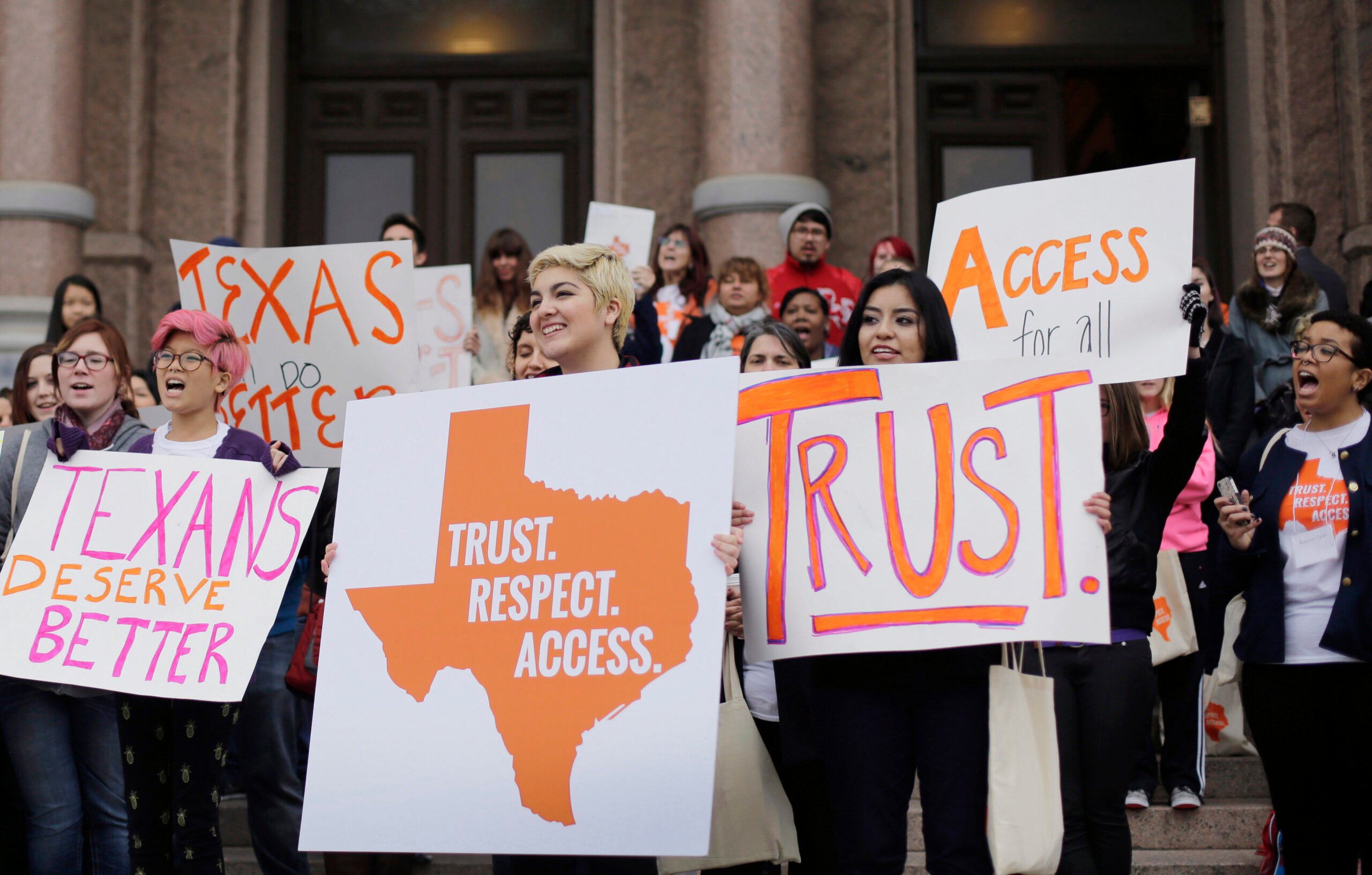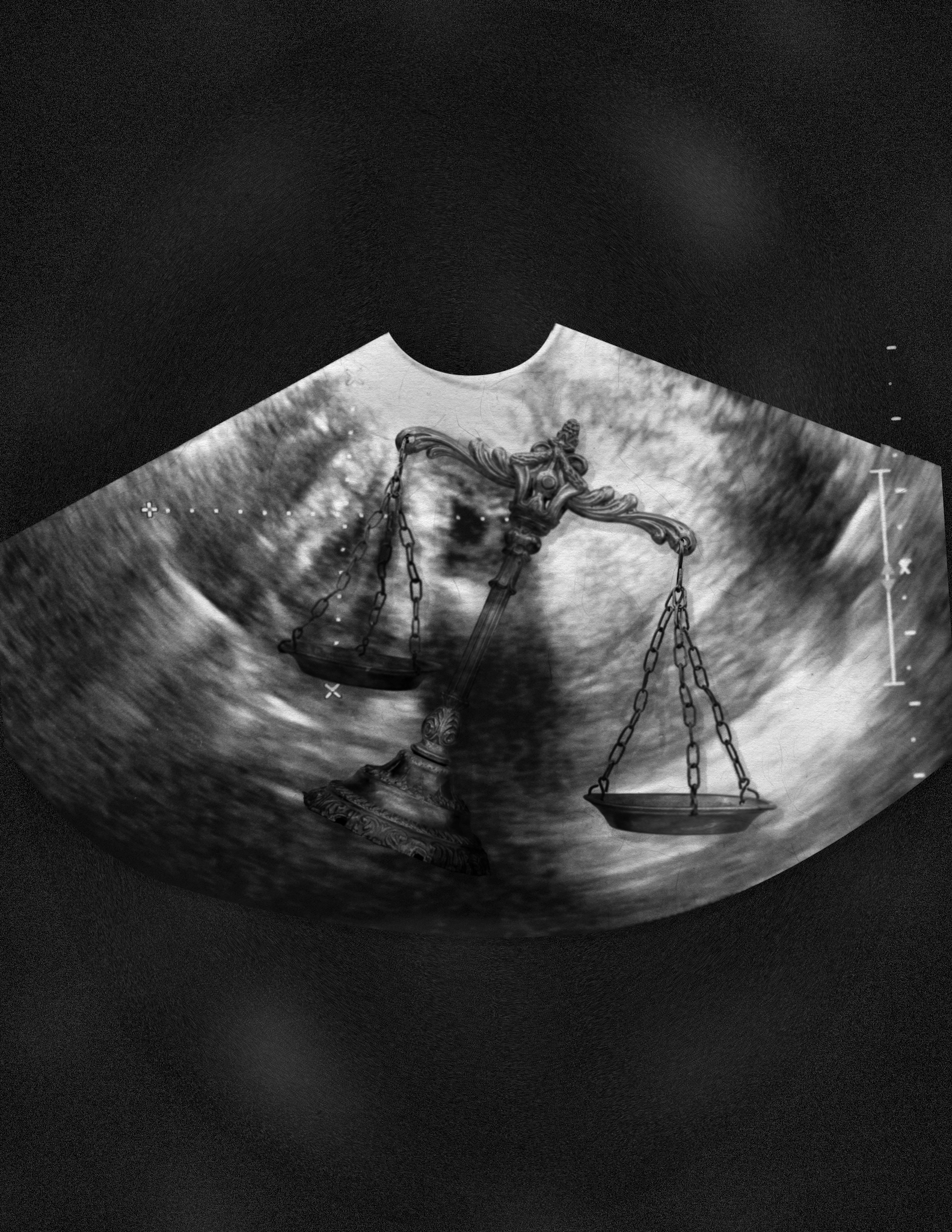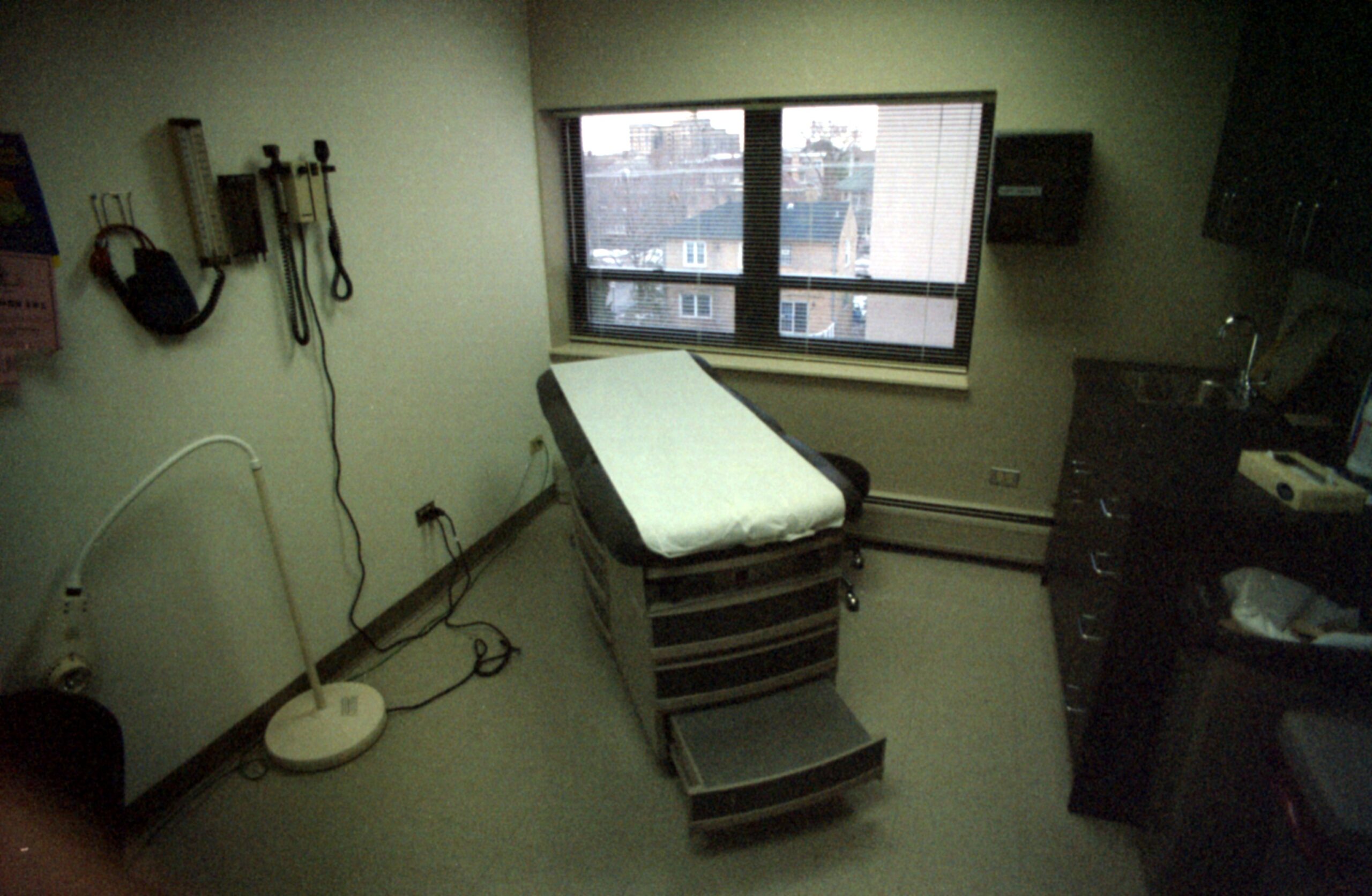
Texas’ New Abortion Law is Driving Women to Extremes
The 20-week abortion ban forced one woman to pawn her wedding ring and flee to Arkansas to terminate her pregnancy.
A version of this story ran in the March 2014 issue.
In late June, when state Rep. Jodie Laubenberg took to the floor of the Texas House in an electric-blue power suit and proposed a ban on abortions past 20 weeks of pregnancy, Sarah Guler wasn’t worried. In fact, she had no idea the fight over abortion was happening. When state Sen. Wendy Davis famously stood for 11 hours to block the bill and when the Texas statehouse became so crammed with protestors that state troopers sealed the doors, even then the news didn’t reach Sarah. As a busy mom in suburban Houston, she didn’t think much about politics. Instead she was preoccupied with child rearing, volunteer work and part-time studies. (Sarah Guler isn’t her real name. The Observer agreed not to reveal her name or certain identifying details.) In September Sarah learned she was pregnant. She and her husband called it their “miracle child.” Because of Sarah’s health problems and two complicated pregnancies, they had feared she’d never conceive again. Now they felt like the luckiest couple alive.
In October, not long into Sarah’s first trimester, Texas’ new anti-abortion bill took effect. Part of the new law required abortion physicians to have admitting privileges at nearby hospitals. The clause involved so much red tape, and proved so difficult to satisfy, that overnight one-third of Texas’ abortion clinics stopped taking patients. Legal challenges ricocheted around the federal courts, causing the media to focus on the distances women now had to travel to get an abortion. The ban on abortions after 20 weeks wasn’t part of the legal challenges, and neither the state health department nor doctors’ groups issued any guidance to health providers or abortion clinics about how they should comply with the new 20-week ban. So it slipped quietly and largely unremarked into law.
A few days before Christmas, the Gulers went to the obstetrician’s office for the 19-week ultrasound. They wanted to know whether to hang a pink or a blue stocking by the fireplace. But they never did find out the gender. Instead they learned that their miracle child had a brain defect so severe that the doctor described it as incompatible with life. Gasping, Sarah asked whether surgery or drugs could fix the condition, but the doctor shook his head. “If you’re looking for a baby that’s going to go to school and play soccer,” he told her, “this is not that child.” The doctor offered to do extra tests but added that the results would be the same. The baby would most likely be stillborn and if it survived birth, would suffer seizures every day of its short life. “If that were me,” Sarah thought, “I’d rather go to God.”
But she and her husband were in for another shock. When Sarah asked when the doctor could schedule an induction to abort the fetus, he shook his head. “We don’t do that here.” Instead, he gave her a list of abortion clinics and told her that she had only seven days to get an abortion. “You have to hurry because there’s a ban,” the doctor told them. “You’re already at 19 weeks. By next Friday, it will be too late.”
In the car on the way home, Sarah began calling the clinics on the list. Only two of them offered abortions up to 20 weeks of pregnancy. What followed was an odyssey of dead ends. Most clinics told her that they only offered abortions up to 16 weeks. One in Dallas referred her to a clinic in New Mexico, but that clinic couldn’t see her until January because it was closed for the holidays. Another clinic in Houston could schedule her on Dec. 26, but after a 24-hour mandatory waiting period she would be too far along to legally abort the fetus. Each receptionist gave Sarah another number to call until eventually she realized she had called some clinics twice. Sarah began to panic. She realized that if she failed to find a clinic in the next week, she would have to spend the remainder of her pregnancy waiting for the baby to die in utero.
“Texas can’t help us,” she said to her husband. “What the hell, let’s call Arkansas.”
There is only one abortion clinic in Arkansas, in Little Rock, and the kindness of the staff there took Sarah by surprise. She felt as if she had encountered compassion for the first time since her world shattered with the terrible news. Sarah received an appointment on Dec. 27 and was warned to psychologically prepare herself for protestors outside the clinic. The procedure would cost $3,500, but because the Gulers were on Medicaid, the clinic reduced the fee to $1,750. Clinic staffers also gave her the contact information for the National Network of Abortion Funds, a donor organization that provided her with further financial aid.
But still, cash was a problem. Her husband had to take time off work to drive to Arkansas, and they would have to borrow money to fix their car, which wasn’t fit for the long journey. They needed money for gas and accommodations as well as for the procedure itself.
The Gulers told only a few people about their plight: someone to look after their two children, two friends who would accompany them for moral support, and a small clutch of relatives whom they hoped would be sympathetic. Even among this select group, some questioned the ethics of their decision. One relative, whose wife had recently delivered a healthy child, suggested tersely that Sarah consult a religious expert before going through with the plan. For this reason, and for fear of condemnation spreading through their small conservative community, the Gulers didn’t tell anyone else.
As she waited for the days to pass before she could leave for Arkansas, Sarah spent sleepless nights searching the Internet. She looked for a hotline dedicated to her situation but was surprised to see support more readily available for drug or sex addicts than for people like her. She looked for stories about babies that had survived the condition her fetus had. She found nothing. Eventually, Sarah looked for information about the abortion clinic in Little Rock. The first page that came up was a garishly designed website labeled “Little Rock Family Planning Services Warning,” dedicated to “exposing the dangers at the Little Rock abortion clinic.” The site claimed that the abortion provider routinely committed safety violations, and speculated that babies were often born alive. It included grisly images of aborted fetuses and photos of the doctor who performed the procedures and his wife.
Sarah began to fear for her safety. She called her regular health provider and begged him to find a way to treat her in one of the specialist hospitals in Houston. She explained that she was going to an unknown clinic in another state and that if something went wrong, she might die. The doctor repeated that he could do nothing more to help her.
Meanwhile, the Gulers still needed money. They borrowed small amounts from friends without saying why they needed it. They threw their January rent money into the pot. The Gulers both hailed from middle-class Texas backgrounds but had fallen on tough times since the recession. Their family business had never quite recovered from the economic downturn, and they frequently wondered whether it would survive another month. Yet they firmly believed that with hard work, their financial luck would change. As they marshaled money to cover the abortion, it felt as if they were falling into a financial hole.
On the way out of town the evening of Dec. 26, still short of money, they stopped at a pawnshop. Sarah ventured inside and surrendered her wedding ring in exchange for cash.
Sarah, her husband and their two friends made the 10-hour drive to Little Rock overnight. It felt like a road trip of the most horrible kind. At gas stops, they shared meals and attempted conversation, but it seemed that they were trapped in a slow-motion nightmare. Near the Texas state line, a burst tire delayed their journey. Sarah had hoped to reach the clinic with enough time to prepare herself, but they arrived only minutes before the appointment. Five protestors, including a child, swarmed them near the clinic entrance. A woman shouted into Sarah’s face: “Ma’am, don’t hurt that child! This is not God’s way! You don’t know what your baby could become!”
Inside, after Sarah completed the paperwork, clinic staff left her alone in a room. On the table lay a book filled with handwritten stories of the women who had come before her. Sarah read about women unable to afford a child, who had split up with their partners, or who had four kids already and didn’t want any more. She flipped through the pages looking for someone like her, but found nothing. Later, the nurse told her that they often treated “genetic cases,” but the women never wrote about it in the book. Sarah understood. She hadn’t done so either, because she couldn’t imagine how to describe such anguish.
The surgical procedure took two days, during which time the clinic staff was consistently reassuring and kind. They explained the procedure, gave her a comfortable floral gown to wear and held her hands as she slipped into sedation. Outside, Sarah’s husband waited in the car. On the second day, a protestor yelled through his window: “You’re supposed to be protecting that woman! What kind of a man are you?”
Within half an hour of coming to on the second day, Sarah had to return to Texas with her husband. They couldn’t afford to stay in a motel for another night. On the drive home, Sarah felt trapped by physical and emotional pain. They drove in silence. A week earlier they’d been buoyed by all the support from family and friends during her pregnancy; now they felt alone. Sarah’s heart, mind and soul felt empty.
In early January, I met Sarah in a coffee shop near her home. By coincidence, she had read the 2012 Texas Observer story (“The Right Not to Know,” April 2012) about my own pregnancy termination. We’d both reeled from our shocking diagnosis of fetal abnormalities, both struggled with the trauma, but that’s where the similarities ended. I’d been able to access an abortion in my own town; Sarah had faced the extra distress of travel. I’d benefited from the compassion of a non-judgmental community—care packages appeared on my porch for weeks after the event—whereas the Gulers are still handling this alone. Sarah took great pains to emphasize the conservatism of her community, explaining that discussions about abortion are impossible, if not dangerous. For this reason, she asked me to give her a pseudonym and to omit any details that might make her identifiable. She told me her story with calm, quiet dignity and paused frequently to highlight the surprising acts of kindness she’d encountered along the way. The humanity of the staff at the clinic, for example, reassured her that empathy exists in unexpected places. She was humbled by the generosity of the Planned Parenthood Federation of America, which wired her cash to cover her January rent, even though she wasn’t a client. The only time Sarah broke down was when she described the protestor who had verbally attacked her husband. “He’s the light of my life,” she sobbed. “How dare they put him in the same category as someone who abandons a woman?”
But Sarah still had questions. If lawmakers had banned abortions after 20 weeks, why didn’t they tell doctors to perform the detailed ultrasound earlier so that pregnant women have time to make a decision? She’d read the law itself and found an exemption for severe fetal abnormalities. Why hadn’t her doctor known this? Finally, the media talked about an abortion ban at 20 weeks, but the law stated that the ban kicked in at 22 weeks of gestation. Had she in fact had another two weeks to make a decision? If so, why hadn’t her doctor or the Texas abortion clinics told her?
I didn’t know the answers either, so I called the experts. Heather Busby, executive director of NARAL Pro-Choice Texas, confirmed that the abortion ban goes into effect at 22 weeks of gestation. However, the law also defines the limit as 20-weeks post-fertilization, which she thought might be difficult for clinic staff and health providers to pinpoint. Doctors usually date pregnancies to the last menstrual cycle. “There’s a lot of fear and confusion out there,” she said, referring to fears of prosecution and the hostility of the anti-abortion movement in Texas, “so providers tend to err on the side of caution” by using 20 weeks post-gestation. Moreover, the wording used in the statute is not medical terminology, she argued: It defines post-fertilization as “the age of the unborn child as calculated from the fusion of a human spermatozoon with a human ovum.” It’s copycat language used by the pro-life movement that appears in similar bills in several other states. “No one knows what lawmakers mean,” Busby said.
It often falls to state agencies to interpret and implement new laws. In early January, I asked the Texas Department of State Health Services whether the agency had issued any guidelines to physicians or abortion facilities about the implementation of the law. It hadn’t. “The aspect of the law was self-implementing,” health department spokesperson Carrie Williams wrote in an email, “no additional guidance letter is needed from us at this time.”
Finally, I spoke to Dr. Moss Hampton, chair of the Texas chapter of the American College of Obstetricians and Gynecologists (ACOG). He confirmed that the obstetric community had not received any information about the implementation of the law. He also echoed Busby’s point about the difficulty of pinpointing the exact stage of pregnancy. “How do you know when fertilization took place?” he asked, adding that such ambiguity makes it difficult for physicians to act within legal bounds. “There’s a firestorm around abortion in this state,” he said. “Any facility that does terminations on a regular basis would be reluctant to bring anyone in close to 20 weeks for fear of violating the law.”
Hampton wasn’t aware of discussions to move the second trimester ultrasound forward. The anatomy scans are more detailed at roughly 22 weeks when the fetus is bigger, he explained, so he didn’t think it would be practical to do them sooner. He confirmed that the condition suffered by the Gulers’ fetus likely would have fallen into the exemption category allowed by the 20-week ban. But like many physicians in Texas, he wasn’t aware of the exemption until our conversation. “Getting word out about this law is well within the bailiwick of ACOG District XI,” he concluded. “We have a newsletter that goes out to all OB-GYNs in Texas. It’s well within what we should be doing.”
Sarah Guler was dismayed when I gave her this information. She should have been exempt from the 20-week ban and legally had more time to make her decision than either her provider or the Texas abortion clinics had thought. “It would have made it so much easier to cope if I hadn’t had to make that trip,” she said to me quietly over the phone. But she was philosophical about the future. “If the leader of the Texas obstetricians puts out that information, then at least this might not happen to anyone else,” Sarah said. “At least that small change will happen because I told my story.”
In late January, Hampton confirmed that the upcoming Texas ACOG newsletter would contain information about the abortion ban, including details for physicians about exemptions for fetal anomalies. In the same week, Williams, the state health department spokesperson, told me that the agency had decided to issue a guidance letter after all, more than three months after the law took effect, to “help ensure licensed facilities were aware.” But the letter shed no further light on the details of the abortion ban, stating simply, “A physician may not perform or induce or attempt to perform or induce an abortion on a woman if the age of the unborn child is 20 or more weeks, effective October 29, 2013.”
The letter also referred physicians to the Texas Medical Board if they wanted additional information. A spokesperson for the Texas Medical Board told me in turn that the board provides information about the bill on its website. But the link leads only to the statute itself. According to the state health department, no further state guidance is planned.


